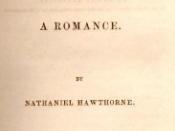The New England settlements of the 17th century regarded above any other institution of the time their Puritanical doctrines which were based on a strict moral code of five major themes, dealing heavily with sin and redemption. The Puritan perception of sin had an opinion in every aspect of Puritan life. Settlers obeyed this perception manifest in the words of the clergy and the Bible meticulously in hopes that they would be received favorably during the final judgment and be accepted into the gates of Heaven. While Christianity has historically had a sound moral structure, Puritanism took that structure to a degree of Fanaticism that resulted in an emotionally oppressive and destitute lifestyle. This lifestyle lead to the preliminary sinful act of Nathaniel Hawthorne's The Scarlet Letter, Adultery, was even considered to be one of the most terrible acts committable, not because of the profound emotional implications on loved ones, but because it was the defilement of a sanctified contract between a man, a woman, and God.
Puritanism was responsible for North America's seriously misguided moral foci of an entire century. When The Scarlet Letter was written in the mid 19th century, North American society had undergone a massive reformation of its moral constructs which was thankfully much more civilized and humane. The general redefinition of morality was largely based on not doing harm to others, whereas the systems of the past were based on the word of the Bible which often asserts empty and pointless conventions. Nathaniel Hawthorne's didactic novel follows in the steps of the social and religious revolutions of his time and could not have been written at a time much earlier than it. It has the fortunate position of retrospection that allows it to use a social setting of the past, an early American settlement,


